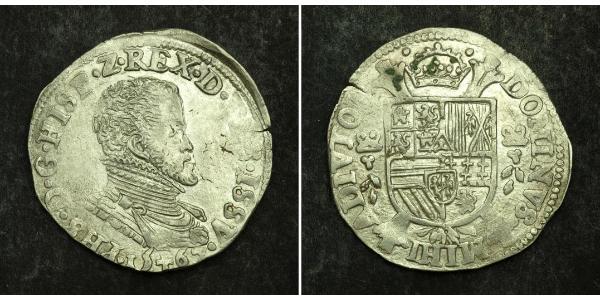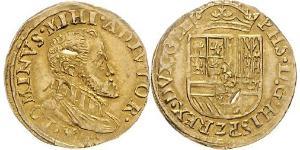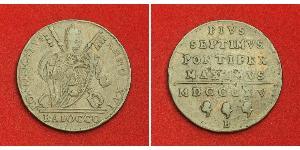(sold for $128.0)
1567, Spanish Netherlands, Overijssel, Philip II. Silver 1/5 Daalder (Ecu) Coin. XF!
Mint Year: 1567
Region: Overijssel (Netherlands)
Reference: v. Gelder / Hoc 212-17c. R!
Denomination: 1/5 Daalder (1/5 Ecu Philippe)
Condition: Monor deposits in reverse, otherweise a nice XF for issue!
Diameter: 30mm
Material: Silver
Weight: 6.09gm
Obverse: Armored bust of Philip II of Spain right. Date (15-67) below, split by privy mark (cross) below.
Legend: PHS . D . G . HISP . Z . REX . D . TRS . ISSV / . I5 + 67 .
Reverse: Crowned arms of the spanish line of the Habsburg between fire irons with flames, St.Andrew's Cross in the background, Golden Fleece Order below.
Legend: DOMINVS · MIHI· ADIVTOR · ("The Lord is my helper!")
Overijssel was formerly known as Oversticht and also included most of the modern-day province of Drenthe. In 1336, it was made part of Guelders, though it was ceded to the Bishopric of Utrecht in 1347. The Bishops ceded the Oversticht to the Emperor Charles V in 1528, who styled himself Lord of Overijssel, thereby giving the province its modern name. The people joined with the other Dutch and rebelled against Charles' heir Philip II. Overijssel became governed by the most powerful mayors and lords in the province.
Philip II (Spanish: Felipe II de Habsburgo; Portuguese: Filipe I) (May 21, 1527 - September 13, 1598) was King of Spain from 1556 until 1598, King of Naples and Sicily from 1554 until 1598, king consort of England (as husband of Mary I) from 1554 to 1558, Lord of the Seventeen Provinces (holding various titles for the individual territories, such as Duke or Count) from 1556 until 1581, King of Portugal and the Algarves (as Philip I) from 1580 until 1598 and King of Chile from 1554 until 1556. He was born in Valladolid and was the only legitimate son of Holy Roman Emperor Charles V.
Under Philip II, Spain reached the peak of its power. Having nearly reconquered the rebellious Netherlands, Philip's unyielding attitude led to their loss, this time permanently, as his wars expanded in scope and complexity. So, in spite of the great and increasing quantities of gold and silver flowing into his coffers from the American mines, the riches of the Portuguese spice trade and the enthusiastic support of the Habsburg dominions for the Counter-Reformation, he would never succeed in suppressing Protestantism or defeating the Dutch rebellion. Early in his reign, the Dutch might have laid down their weapons if he had desisted in trying to suppress Protestantism, but his devotion to Catholicism and the principle of cuius regio, eius religio, as laid down by his father, would not permit him to do so. He was a devout Catholic and exhibited the typical 16th century disdain for religious heterodoxy.
One of the long-term consequences of his striving to enforce Catholic orthodoxy through an intensification of the Inquisition was the gradual smothering of Spain's intellectual life. Students were barred from studying elsewhere and books printed by Spaniards outside the kingdom were banned. Even a highly respected churchman like Archbishop Carranza, was jailed by the Inquisition for seventeen years for publishing ideas that seemed sympathetic in some degree to Protestant reformism. Such strict enforcement of orthodox belief was successful and Spain avoided the religiously inspired strife tearing apart other European dominions, but this came at a heavy price in the long run, as her great academic institutions were reduced to third rate status under Philip's successors.
However, Philip II's reign can hardly be characterized as a failure. He consolidated Spain's overseas empire, succeeded in massively increasing the importation of silver in the face of English, Dutch and French privateers, and ended the major threat posed to Europe by the Ottoman navy (though peripheral clashes would be ongoing). He succeeded in uniting Portugal and Spain through personal union. He dealt successfully with a crisis that could have led to the secession of Aragon. His efforts also contributed substantially to the success of the Catholic Counter-Reformation in checking the religious tide of Protestantism in Northern Europe.
The Philippines, a former Spanish colony, are named in his honor.

|
Posted by:
anonymous 2015-12-16 |
2 Florin / 2 Gulden Austria-Hungary (1867-1918) Silver Franz ...
group has 20 coins / 18 prices
⇑
1 Dollar China Silver
group has 35 coins / 34 prices
⇑
















-300-150-KgQKX9ISLlMAAAFYVIy668M0.jpg)








